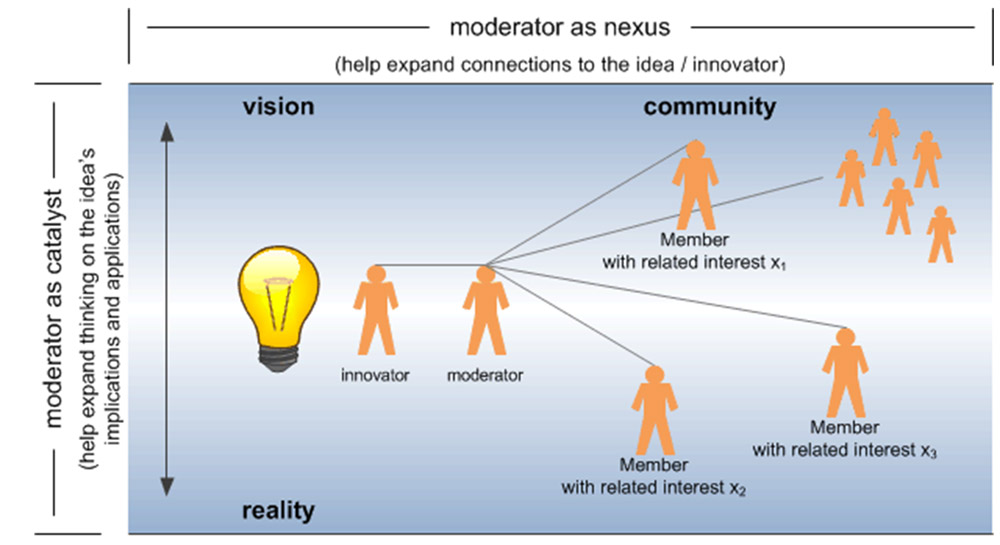By: Doug Collins
Ideas communities are a hot topic but do you really know how to make them work effectively? Doug Collins brings his experience as a community manager to bear on the roles and resources needed to catalyze great ideas.
At some point in my engagement with clients the question of roles arises. Who does what to help realize the potential for transformation that collaborative innovation offers? What strengths does the person sitting to my left possess that makes them the right person for a given role? Do we assign people to positions or do they claim ownership of the work as we evolve the project, just as they claim ownership of the practice of innovation?
In turn, what does the innovation program commit to the people in each role by way of training, recognition, and an opportunity for them to realize their leadership potential? What does the program invite the people to create together that they could not do on their own?
Some roles seem straightforward: the role of sponsor, for example. Typically one individual—or a small cadre—convenes the community, inviting members to engage on one or more critical questions facing the group. The sponsor holds a position within the organization where they in turn can help the community effect change. That’s straightforward and unambiguous: convene and facilitate.
The moderator, who also plays a crucial role in the community, may by comparison seem to have a more nebulous charter. For example, does the moderator serve as the community equivalent of a referee: someone who runs up and down the field, enforcing fair play, but doing their best not to interfere with the game? Or, should they intervene? Can one moderator work effectively across multiple communities?
In this article, which serves as a deeper dive on the larger questions around resourcing that I covered in a previous column, I share perspective on the personalities and practices that lead to effective moderation.
1 The Moderator as Catalyst and Nexus
To start, every community benefits from the presence of a trained, designated moderator. Do not leave the role vacant. The moderator serves two critical functions that you, the leader of the collaborative innovation program, must support in order to meet your commitments: catalyst and nexus.
To start, every community benefits from the presence of a trained, designated moderator. Do not leave the role vacant.
As a catalyst the moderator engages with the people who contribute and build ideas, challenging them to explore and extend their thinking by asking a series of probative questions that start with, “How might we…?” or “What if we…?”
The moderator helps the innovator, along with community members, to realize the full potential of their contribution, challenging them to consider the full implications of the vision behind their ideas while also exploring potential application areas.
Figure 1 depicts how, in serving as the catalyst, the moderator can help the innovator more fully develop the scope of their thinking about their idea by posing questions along the cognitive spectrum that goes from vision to reality.
Figure 1: the moderator, as catalyst, engages the innovator across the cognitive spectrum
The moderator, moreover, does not probe for why the idea may not work. (The innovator laments that too many of their colleagues embrace this role. No need to formally assign someone the job.) The moderator does not serve as a screen or gate. Catalysts initiate and accelerate reactions, not retard them. The probative nature of the moderator’s enquiry may help the innovator more clearly and more fully articulate the possibilities their idea offers in terms of addressing the critical questions facing the community (i.e., “How might the implications behind this idea relate to the challenge at hand?”). However, the moderator does not engage in this form of dialogue with the intent of culling ideas.
As the nexus, the moderator helps the innovator make connections within the community amongst people who share an interest in the topic and would have strong contributions to make in evolving the idea, if only they knew the idea had been submitted. The moderator helps create this awareness amongst the members.
As the nexus, the moderator helps the innovator make connections within the community amongst people who share an interest in the topic and would have strong contributions to make.
In my dialogue with clients I ask them if they can think of a person in their organization who seems to know everything that happens in the building or the organization at large. If Marvin Gaye heard it through the grapevine then he likely got his intelligence from the contemporary of this individual at Motown Records. The client smiles. They know exactly who holds this position within the group. They always do. These people can serve as effective moderators based on their history of making connections.
The next questions that typically arise: Should the moderator have deep technical knowledge of the subject they’re moderating? Does the moderator need to have the most knowledge about the subject to effectively serve in the role?
No. In fact, people can handicap themselves as moderators when they enjoy a high level of expertise or experience with the question at hand. They can inadvertently begin to screen ideas and influence the direction of their evolution by the nature of their questions or with comments that reference past, unsuccessful forays into this domain. Nothing kills effective moderation more quickly and more resoundingly than the comment, “We tried this before (and it did not work).”
The moderator, as nexus, opens doors for the innovator by helping them make new connections. Figure 2 depicts the dual role of the moderator.
Figure 2: the moderator as catalyst and nexus
2 How Many Moderators?
Once clients gain a perspective of the role the moderator plays, they next want to know how many moderators they should invite to participate in the community.
The answer varies by program and by community, of course. What I typically find is that nobody has the time to serve as a moderator full time. And, that’s a good thing. It’s the nature of the connections that people make and the insights they form in their daily work that enables them to serve effectively in this role.
To this end, the resource calculation becomes a function of balancing the number of ideas circulating in the community with the number of minutes per day the moderator can devote to the role. Figure 3 depicts the equation.
Figure 3: calculating the number of moderators per community
For example, let’s say that the community contributes ten (10) ideas per week, or two (2) ideas per day, Monday through Friday. Let’s say that the ideas tend to be relatively complex, such that the moderator chooses to spend twenty (20) minutes per idea contemplating the concept, collecting their thoughts, posing the probative questions, and reaching out to members who may share an interest in the topic.
Let’s say, too, that that the average level of activity on each idea is high, such that the moderator would want to keep up to date with the latest comments and reviews. Finally, let’s say that the moderators in the organization choose to spend on average one hour each morning, coffee in hand, engaging with the community.
Plugging these parameters into the equation would suggest that one moderator, or 5/6 of one, could effectively engage this community. Figure 4 depicts this scenario.
Figure 4: example resource calculation
Common sense dictates that the above equation can serve only as a rough guide for resourcing the role. The complexity and activity factors remain wholly subjective, for example, and communities tend to ebb and flow, depending on the stage of the campaign. Your mileage will vary, but you now have a place to start.
In closing, the moderator serves a valuable, necessary role in the community. They help the innovators more fully explore and articulate their ideas, improving the quality of their contribution. They help connect members who share an interest in ideas, improving the diversity of thought and perspective that goes into each potential innovation.
As the program or challenge sponsor, you benefit from the gifts the moderator brings to the table when you identify people who, by their nature, find they can readily serve as catalyst and nexus, and when you support them in this capacity by helping them understand their charter. Recruit your moderators early in the planning stage for each community. Train them. Support them. The quality of their work and the extent to which they take ownership of the role heavily influences the success of the program.
By Doug Collins
About the Author:
 Doug Collins serves as an innovation architect. He has served in a variety of roles in helping organizations navigate the fuzzy front end of innovation by creating forums, venues, and approaches where the group can convene to explore the critical question. He today works at Spigit, Inc., where he consults with Fortune 1000 clients on realizing their vision for achieving leadership in innovation by applying social media and ideation markets in blended virtual and in-person communities.
Doug Collins serves as an innovation architect. He has served in a variety of roles in helping organizations navigate the fuzzy front end of innovation by creating forums, venues, and approaches where the group can convene to explore the critical question. He today works at Spigit, Inc., where he consults with Fortune 1000 clients on realizing their vision for achieving leadership in innovation by applying social media and ideation markets in blended virtual and in-person communities.
Previously, Doug formed and led a variety of front end initiatives, including executive advisory programs for industry influencers, early adopter programs for lead users, corporate strategic planning, and structured explorations of new market and product opportunities. Before joining Spigit, Doug worked at Harris Corporation and at Structural Dynamics Research Corporation which is now part of Siemens Corporation.




